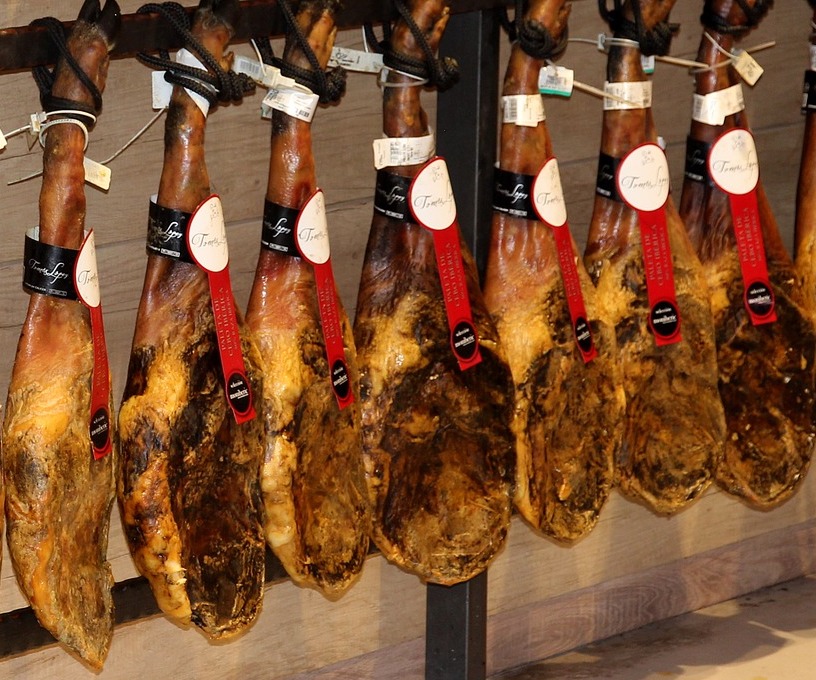Dry Curing
Dry cures of salt, sugar, curing salts, and spices enhance the flavor, texture, and appearance of foods as a prep step when aging, fermenting, smoking, barbecuing, or roasting. Ham, bacon, salt pork, pancetta, and, gravlax are examples of foods that are dry-cured.
Sanitation
When curing perishable foods sanitation is of the utmost importance so always keep foods cold, between 36-40° F/2-5° C, keep work areas meticulously cleaned and sanitized, and avoid cross-contamination by periodically cleaning or changing cutting boards when prepping different meats. Use the correct ratio of salt for the product, and for extended dry cures use nitrites and nitrates to avoid botulism.
Key Components of a cure
Curing involves the introduction of salt and seasonings while extracting moisture to create a desired texture and flavor.
Salt
Use kosher salt or a coarse salt without iodine.
Always measure cures by weight and not volume because a cup of salt, depending on the type, can weigh from 5-9 oz./150-270 g.
Prague Powder #1
Curing Salts
Curing salts are powerful agents that eliminate botulism and help make the foods safe to eat. There are two types of curing salts and different uses for each type. Curing salts are concentrated and intended to be used in minute quantities, about 1 oz./30 g per 1 Lb./450 g. per 25 lb./11.25 kg. of meat.
Curing Salt #1 – Pink Salt
T.C.M. (Tinted Curing Mix), Prague Powder #1, Insta Cure #1, DQ Curing Salt
Contains 93.75% salt and 6.25% nitrites and is tinted pink to distinguish it from common salt.
Curing Salt #2
Prague Powder #2, Insta Cure #2, DQ Curing Salt #2
Contains nitrates and is used in the production of fermented sausages that are not cooked.
Sugar
Sugar, in the form of white or brown cane sugar, honey, corn syrup, agave syrup, and maple syrup, adds flavor and reduces the harshness of the salt. The flavor doesn't penetrate the product much (about 1/4 inch/6 mm), rather adding mostly surface flavor. Sugar also feeds flavor-producing bacteria in the product.
Herbs and Spices
Flavor profiles can be created based on traditional combinations, ethnic cuisines, or new classics. A French confit uses a classic quatre-epice spice combination for curing duck and goose.
Instacure #2
Honey
Basic Cure
4 part salt
1 part sugar or dextrose
Curing salt
Herbs, spices, and flavorings as desired
Sweet Cure
2 parts salt
1 part white or brown sugar, honey, maple syrup, corn syrup, agave syrup
Curing salt
Herbs, spices, and flavorings as desired
Time
The length of time is dependent on the density of the product and the desired texture and taste. If a product sits too long in a cure it can become salty. The bigger the item the longer it will take for the cure to reach the center.
Temperature & Humidity
Dry cured hams are hung at 50-60° F/8-15° C
Temperature and humidity work in concert when curing meats for extended times. 36-40°F/2-5° C is a safe temperature range for curing meats with nitrites but some methods call for temperatures between 50-60° F/8-15° C depending on the style of cure and the type of meat. Humidity is important as is airflow in the curing process. Humidity should be around 60% which is well below the78% average for most commercial coolers (some are as high as 84-86%).
How Much Cure to Use
Generally, dry cures are used at about 3-4% of the weight of the product. More or less may be used depending on the thickness of the product, the density of the proteins and connective tissue, and the desired texture and flavor. For dry-cured whole hams, 6-10% of dry cure by weight is the standard usually applied in three stages over the course of curing.
Procedure
The simplest way to dry cure meats is to rub or dredge the product in the cure. The product can be sealed in plastic and turned every other day. Because of the delicate nature of the flesh of fish, the cure is usually packed on the fillet and it is then wrapped in cheesecloth.
The salt box method layers the product in a pan with the cure. It is then weighted down with pressure to extract the liquids. The liquid is discarded as the product is rotated every other day. During curing the product should be stored at temperatures between 32°- 40°F/0°-5° C
Curing Time
Curing times vary depending on the size, density, and desired outcome. Generally, 7 days per inch of thickness is the standard length of time for the salt curing process to be effective. A side of salmon takes 1-3 days, a side of bacon typically takes 7-14 days and a large ham could take 30-40 days.
Soaking & Rinsing
When the curing period has passed the product should be rinsed. For larger items soaking in cold water for one hour is recommended. Scrub the product to remove the entire cure and allow it to dry by air circulation under refrigeration. Items can be placed on wire racks or hung from hooks in coolers.
Aging
Aging is done to dry the product and to achieve a particular taste and texture. A side of salmon may be aged overnight, a side of bacon for 2-3 days, or in the case of large hams 45-180 days. For extended aging, the temperature, humidity, and air circulation are important in drying the surface of the product, particularly at the beginning of the process. Exhaust fans with humidity controls are often incorporated. Dry curing and aging result in moisture loss, for large hams 8- 12% weight loss is common and may be as high as 30%.
Smoking
Upon proper aging the item can then be cold or hot-smoked as desired.










